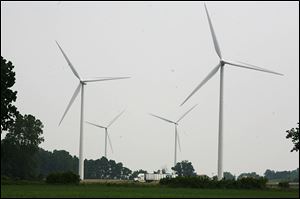
EDITORIAL
Collateral damage
12/30/2013
Wind turbines provide clean energy, but may pose a threat to wildlife. These turbines are near Bowling Green.
For Ohio’s — and America’s — environmental and economic health, the transition from fossil fuels to renewable sources to meet the nation’s energy needs must continue and even accelerate. Greater reliance on wind power is an essential part of the process, but that will require a better balance between energy production and wildlife preservation than the nation has achieved so far.
Last month, the Obama Administration announced a plea agreement with the renewable-energy division of Duke Energy Corp. over the killings of 14 eagles and 149 other birds at two wind farms in Wyoming. As it agreed to pay a $1 million penalty, the company acknowledged, according to the Justice Department, that “it constructed these wind projects in a manner it knew beforehand would likely result in avian deaths.”
That response to excessive bird deaths at wind-power sites was overdue. Last September, a federal report concluded that wind turbines killed at least 67 bald and golden eagles in the past five years. Turbines also pose a potential threat to other species of birds and bats.
But the administration’s concern appears contradicted by its support for a new federal rule that would allow wind producers to operate for three decades before they have to show in detail that their turbines are not killing such sensitive species as bald and golden eagles. Previously, wind farms near known eagle nests had to get new federal permits every five years, and had to meet specific criteria related to bird deaths.
Supporters of the new regulation argue that it will encourage investors’ confidence by creating greater certainty for wind projects. But they insist it will continue to provide adequate protection of affected species.
The issue has particular resonance for northwest Ohio, which has some of the most important habitats for birds — including bald eagles — in the world. Our area has made special bird preservation and recovery efforts.
Yet two wind projects in Ottawa County are going forward amid complaints that their turbines pose risks to bald eagles and migratory birds. The projects are at Camp Perry and a business park in Erie Township; the latter already has a turbine. Both sites are uncomfortably close to the Ottawa National Wildlife Refuge and to dozens of eagle nests.
Bird enthusiasts and other environmental advocates argue that wind power can’t properly claim a green label, since turbines kill as many as 500,000 birds each year. Wind producers counter that man-made climate change aggravated by dirty air is a far greater threat to birds — and other species, including humans — than turbines.
Surely, though, there is ample room for common ground. Wind farms need to be sited and operated with proper consideration for birds’ habitats and flight paths. In northwest Ohio, that means keeping new farms at a rational distance from the Lake Erie shoreline and bird flyways.
Wind producers need to install better defenses against birds flying into massive turbines, especially during peak migration times, and those efforts must be subject to regulatory monitoring. Nothing prevents Ohio environmental officials from continuing to impose stricter standards on wind projects than the federal government does.
It took a lot of work to remove the bald eagle from the nation’s list of endangered species in 2007. That process included regulations that adequately balance development and conservation. Wind farms must be subject to the same balance.